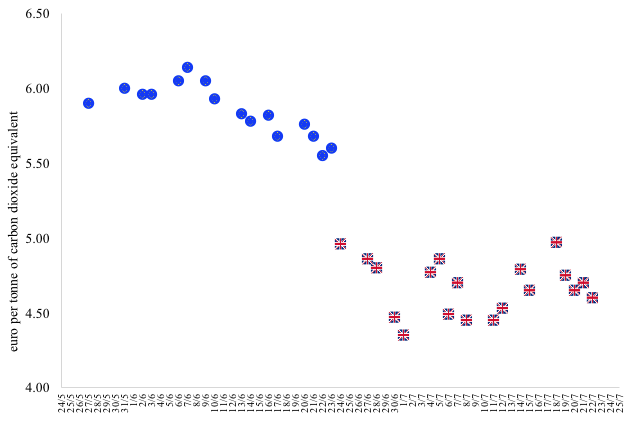Despite the title, this column is not about an end to sex with extra-terrestrials. It is about the impact of Brexit on the European Union Emissions Trading System (EU ETS). The UK does not need to leave the ETS when leaving the EU. Norway, Iceland and Liechtenstein are all inside the ETS but outside the EU. But at the moment we only know that "Brexit means Brexit", so there is a possibility that the UK will leave the ETS as well as the EU.
The ETS is currently in its third phase, which runs from 2013 to 2020. Permits are valid for the entire period. Intertemporal fungibility is necessary because energy use and thus carbon dioxide emissions vary with the weather. If permits were valid for a single year, an early cold snap could imply that all permits for that year would be used by Christmas. The chance of this happening is much smaller for multi-year permits.
The multi-year emission budget poses a problem for ETSexit. If the UK leaves the EU on 1 January 2021, there is no problem. The third phase of the ETS will conclude with the UK, and the fourth phase will start without it. Preparations for the fourth phase would need to be partly redone, but that is about it. However, if the UK leaves before that, it gets complicated.
The overall number of emission permits in the ETS will have to be adjusted downwards to reflect the share of the UK. This is not complicated in principle. Permits are issued and auctioned at regular intervals, and the authorities have two years to prepare once the UK invokes Article 50. This is not unprecedented (Chaton et al. 2015, Hu et al. 2015, Richstein et al. 2015, Grüll and Taschini 2011), but there may be a political problem. Previous attempts to adjust the volume of permits exposed the fragile compromise behind EU climate policy, reflecting different priorities in eastern, western and southern Europe. It may be that the European Commission, for example, would need to buy back some pre-allocated permits.
In recent years, the UK has been a net importer of emission permits. In 2013, 7.9% of emissions in the UK were covered by permits bought from other European countries, according to UK Government figures. By 2014 it was 11.5% in 2014. The UK Government's Climate Change Act (2008) has a commitment to reduce emission by 29% compared to 1990. This corresponds to 18.9% and 25.4% of the emission reductions in 2013 and 2014, respectively. ETSexit thus implies a sharp, upward shock in the cost of emission reduction in the UK. Assuming a quadratic cost function, costs would increase by 40% or more.
The UK was responsible for 13.5% of 2013 emissions in the EU (and Iceland) and for 13.0% in 2014.1 This is projected to fall to 8.2-8.4% in 2020 (EEA 2015). As only the final few years of an eight-year budget period are affected, ETSexit thus implies a mild, downward shock in the price of emission permits. The UK’s projected emission allocation for 2020 is around 140 million tonnes of carbon dioxide equivalent, which is small relative to the backloading of 900 million allowances to 2019-2020.2 Nonetheless, the average permit price at auction was €5.86/tCO2 in the four weeks before 23 June, and €4.67/tCO2 in the four weeks after (Figure 1),3 a price drop of €1.26/tCO2 (s.e. €0.03/tCO2), or 20%. Price volatility may increase in the run-up to ETSexit as UK companies sell the permits they stocked for the final years of the budget period, or the options to buy such permits.
Figure 1 The auction price of greenhouse gas emission reduction permits in the four weeks before the referendum (23 June 2016) and the four weeks after
Although the ETS is administered by DG Climate Action of the European Commission, monitoring of emissions and enforcement of emission reduction is the responsibility of member states. The UK has been a net importer of permits, but many permits that originate in the UK circulate in the rest of Europe. These permits are regulated by the Environment Agency (for England), the Scottish Environment Protection Agency, the Northern Ireland Environment Agency, Natural Resources Wales and, for offshore installations, the Department of Business, Energy and Industrial Strategy. Upon ETSexit, these agencies will need to agree to continue to implement Directive 2003/87/EC and its amendments lest UK permits lose their legal standing in what remains of the EU.
Emission permits are licences. If you buy a loaf of bread, you have a loaf of bread even if the baker subsequently loses its licence to bake bread. If you buy an emission permit, and the regulator of the issuer of that permit subsequently stops regulating, then the permit is worthless.
It is beneficial for the UK to stay in the ETS. Upon ETSexit, a major part of UK climate policy disappears. The UK government has always argued for more stringent emission targets than Brussels (Veenman and Liefferink 2012). Without the ETS, it will be more difficult to meet those targets and the UK will have to set up alternative regulations in time for ETSexit. UK companies may be entitled to compensation for the de facto expropriation of the excess EU permits and futures that they own, or for the losses incurred as they sell off permits in the months leading up to ETSexit.
The ETS also covers emissions from aviation. The original intention was to cover all emissions from flights that landed or departed in the EU. This was abandoned under pressure from airlines from countries outside the EU, and from airports inside the EU because hub airports on Europe’s borders would gain an advantage (Fitz Gerald and Tol 2007). At the moment, only flights that depart and land in the EU are covered. ETSexit would mean that some of Europe’s busiest airports would no longer be part of the ETS. Previously, hub airports like Istanbul or Zurich threatened to take away European business should the ETS cover flights outside Europe too. After ETSexit, Heathrow would be a threat as well.
At the time of writing, we do not know which European institutions the UK will Brexit. Leaving the ETS would pose a problem to the EU unless it happens on 1 January 2021. Leaving the ETS would be problematic for the UK at any time. It would therefore be advisable for the UK government to rule that Brexit does not mean ETSexit. If not, it should prepare for a major overhaul of UK climate policy.
References
Chaton, C., A. Creti, and B. Peluchon (2015), "Banking and back-loading emission permits." Energy Policy 82 (1):332-341. doi: 10.1016/j.enpol.2015.01.023.
EEA (2015), Trends and projections in Europe 2015 - Tracking progress towards Europe's climate and energy targets. Copenhagen: European Environment Agency.
Fitz Gerald, John D., and Richard S. J. Tol (2007), "Airline Emissions of Carbon Dioxide in the European Trading System." CESifo Forum (1):51-54.
Grüll, G., and L. Taschini (2011), "Cap-and-trade properties under different hybrid scheme designs." Journal of Environmental Economics and Management 61 (1):107-118. doi: 10.1016/j.jeem.2010.09.001.
Hu, J., W. Crijns-Graus, L. Lam, and A. Gilbert. 2015. "Ex-ante evaluation of EU ETS during 2013-2030: EU-internal abatement." Energy Policy 77:152-163. doi: 10.1016/j.enpol.2014.11.023.
Richstein, J. C., T. J. L. Chappin, and L. J. de Vries. 2015. "The market (in-)stability reserve for EU carbon emission trading: Why it might fail and how to improve it." Utilities Policy 35:1-18. doi: 10.1016/j.jup.2015.05.002.
Veenman, S., and D. Liefferink (2012), "Different countries, different strategies: 'Green' member states influencing EU climate policy." In A Handbook of Globalisation and Environmental Policy, Second Edition: National Government Interventions in a Global Arena, 387-414.
Endnotes
1 http://ec.europa.eu/eurostat/en/web/products-datasets/-/ENV_AIR_GGE
2 http://ec.europa.eu/clima/policies/ets/reform/index_en.htm
3 https://www.eex.com/en/market-data/emission-allowances/auction-market/european-emission-allowances-auction/european-emission-allowances-auction-download




